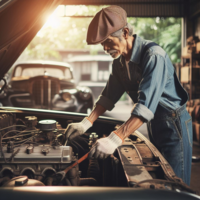The Encroaching Challenge
 How the Automobile Industry is Making Cars Harder for Regular People to Repair
How the Automobile Industry is Making Cars Harder for Regular People to Repair
Introduction:
The automobile industry has undeniably undergone remarkable advancements over the years, with innovations that have enhanced safety, performance, and efficiency. However, amidst this progress lies a growing concern: the increasing complexity of modern vehicles and the challenges they pose for regular people to repair. Once a pastime for hobbyists and a cost-saving measure for budget-conscious individuals, repairing one's vehicle has become a daunting task, with barriers created by manufacturers that seem to prioritize profit over consumer empowerment.
1. **The Rise of Technological Complexity:**
- Modern vehicles are equipped with an array of sophisticated technologies, from advanced computer systems to intricate electrical components. While these innovations offer benefits such as improved fuel efficiency and enhanced safety features, they also contribute to the complexity of vehicle repairs.
- Diagnostic tools required to identify issues have become specialized, often necessitating proprietary software and equipment that are inaccessible to average consumers and independent repair shops.
- The integration of software-driven systems further complicates repairs, as issues may not be readily apparent without access to manufacturer-specific diagnostic codes and protocols.
2. **Obstacles to Accessing Repair Information:**
- Manufacturers control access to repair information and diagnostic codes, limiting the ability of independent repair shops and individuals to effectively troubleshoot and fix problems.
- Proprietary software and tools are often required to access critical repair data, leaving consumers reliant on dealership services and facing inflated repair costs.
- Some manufacturers employ tactics such as encrypted software and electronic locks to prevent third-party access to vehicle systems, effectively creating a monopoly on repair services.
3. **Restricted Access to Parts:**
- The automobile industry's shift towards proprietary parts and components further hampers consumer repair efforts. Manufacturers often design parts that are uniquely compatible with their vehicles, making it difficult to find alternatives in the aftermarket.
- Intellectual property rights and patents are used to restrict the production and distribution of third-party replacement parts, driving up costs and limiting consumer choice.
- The trend towards integrated assemblies, where multiple components are combined into a single unit, means that even a minor issue may require the replacement of an entire assembly, increasing repair expenses.
4. **Legislative and Regulatory Challenges:**
- Despite efforts to address the issue, legislative measures aimed at ensuring consumers' right to repair have faced opposition from manufacturers.
- Lobbying efforts by automobile companies have influenced policymakers to enact laws and regulations that favor restrictive repair practices, further entrenching the barriers to independent repair.
- The lack of standardized regulations across jurisdictions complicates advocacy efforts and leaves consumers vulnerable to exploitation by manufacturers.
5. **Impact on Consumer Rights and Sustainability:**
- The erosion of consumers' ability to repair their vehicles undermines their rights to ownership and self-determination, perpetuating a cycle of dependence on manufacturers for maintenance and repair services.
- Restricted access to repair information and parts contributes to a throwaway culture, where consumers are incentivized to replace rather than repair vehicles, leading to increased waste and environmental degradation.
- The lack of transparency in repair processes and the prevalence of disposable components hinder efforts towards sustainability and resource conservation in the automotive industry.
6. **The Role of Consumer Advocacy and Technological Innovation:**
- Grassroots movements and consumer advocacy groups have emerged to challenge the status quo and demand greater transparency and accessibility in the repair process.
- Technological innovations such as open-source diagnostic tools and community-driven repair forums offer alternative solutions to traditional dealership services, empowering consumers to take control of their vehicle maintenance and repair needs.
- Collaborative efforts between independent repair shops, consumer advocacy organizations, and policymakers are essential in driving legislative change and promoting fair competition in the automotive repair industry.
Conclusion:
The automobile industry's transition towards increasingly complex and proprietary repair practices poses significant challenges for regular consumers, limiting their ability to maintain and repair their vehicles independently. As manufacturers prioritize profit margins and control over aftermarket services, consumers face inflated repair costs, restricted access to repair information and parts, and diminished rights to ownership and sustainability. However, through grassroots activism, technological innovation, and concerted advocacy efforts, there is hope for a future where consumers regain control over their vehicles and the repair process, fostering a more equitable and sustainable automotive industry.
Mind Detour offers humorous, educational and interesting articles and videos to detour your mind from the everyday grind.
Be sure to follow us on Twitter and like our page on Facebook.
Thank You for visiting my site, I really appreciate it! Please do me a huge favor and share my articles with your friends on social media.



